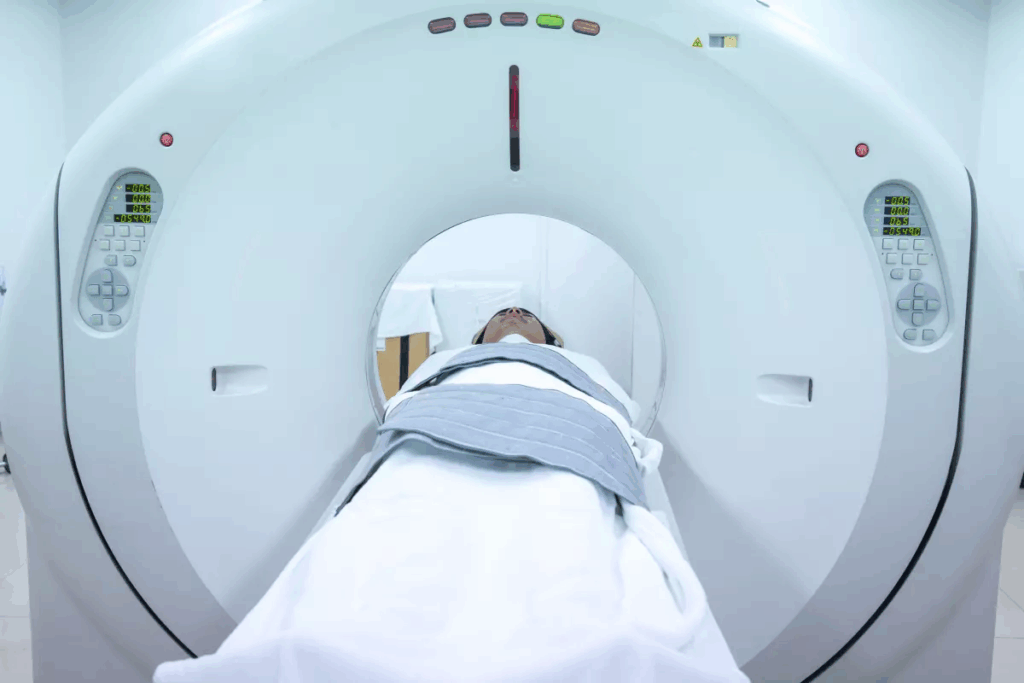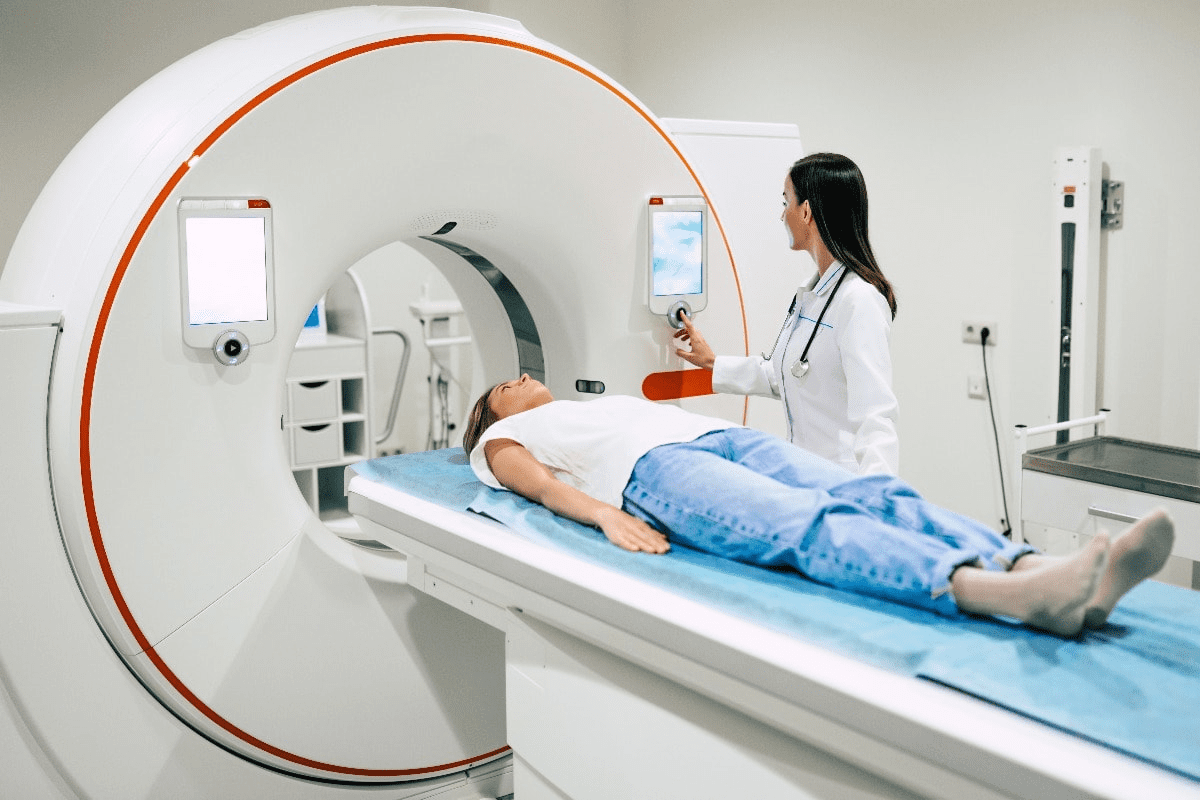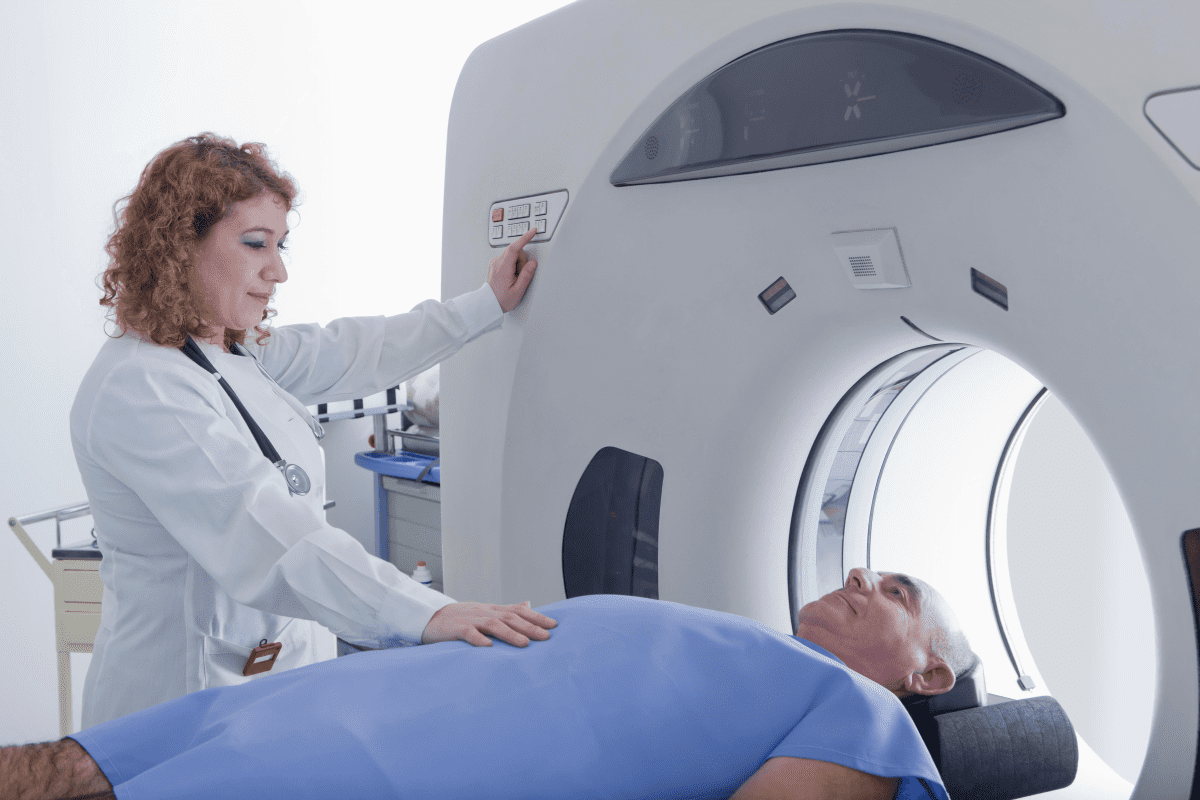
Medical imaging technology has changed how we diagnose and treat kidney disease. CT kidney scans are now key tools for specialists. They help find kidney disease and its causes with great accuracy.
Kidney disease is a big health issue worldwide, often tied to high blood pressure. Advanced CT imaging lets specialists spot kidney disease early. This means they can start treatment sooner.
At Liv Hospital, our team of experts works together. They use top-notch imaging and team support for better care.
How do CT kidney scans help hypertension specialists diagnose kidney disease and find structural causes of high blood pressure?

Hypertension and kidney disease are closely linked. High blood pressure can harm the kidneys’ blood vessels, making them less effective. On the other hand, kidney disease can cause high blood pressure by messing with the body’s fluid and hormone balance. This can make kidney damage worse.
The relationship between hypertension and kidney disease is a cycle that’s hard to stop. Hypertension specialists and kidney and hypertension specialists must work together. High blood pressure can damage the kidneys, leading to a decrease in function and a buildup of toxins. This can cause blood pressure to rise even more, starting the cycle again.
It’s key to understand this cycle to create effective treatment plans. By controlling blood pressure, we can slow kidney disease. Managing kidney disease can also help control blood pressure.
About 10.8% of the world’s population has chronic kidney disease. This is a big health issue worldwide. It shows we need to raise awareness and screen more, mainly in high-risk groups.
The high number of people with chronic kidney disease stresses the need for early detection. Hypertension specialists can help slow disease progression and lower the risk of serious problems if they catch it early.
Chronic kidney disease has a big impact on public health. It raises healthcare costs and death rates. Early screening and detection are key to managing the disease and easing the healthcare system’s load.
People with risk factors like hypertension, diabetes, or a family history of kidney disease should get screened regularly. This way, we can catch problems early and stop them from getting worse.

CT kidney scan technology has changed how we diagnose kidney diseases. It gives detailed views of kidney structure and function. This helps doctors make precise diagnoses and plan effective treatments.
CT scans use X-rays and computers to make detailed images of the kidneys. An X-ray tube rotates around the body, capturing images from different angles. These images are then turned into detailed 2D and 3D views of the kidneys.
This technology has improved a lot. Modern machines scan faster and produce clearer images. This is key for accurately and quickly diagnosing kidney issues.
The development of kidney-specific CT protocols has grown over time. Early CT scanners had poor resolution and slow scan times. But, as technology got better, so did our ability to see the kidneys clearly.
Now, we have advanced protocols for kidney imaging. These are designed to show renal structures in the best way possible. They help spot small issues that might be missed with older methods.
Conventional X-rays have been used for years, but they have big drawbacks for kidney imaging. Unlike CT scans, X-rays give 2D images that can be blocked by other structures. This makes it hard to see the kidneys clearly.
Using CT kidney scan technology helps us make more accurate diagnoses. This leads to better treatment plans for patients with kidney disease.
CT kidney imaging is key for hypertension specialists. It helps us see how kidneys work and what’s wrong with them. This info helps us decide the best treatment.
CT imaging shows us kidney details clearly. We see the kidney’s inside, the renal pelvis, and the tissues around it. These clear images help us spot small problems that other tests miss.
CT imaging also checks how blood flows in kidneys. It shows us if there’s a blockage in the blood vessels. This is important for finding the cause of high blood pressure.
Benefits of CT Kidney Imaging | Description |
Superior Visualization | Detailed images of renal structures |
Assessment of Renal Blood Flow | Evaluation of vascular structure and function |
Detection of Kidney Stones and Tumors | Identification of possible hypertension causes |
We use CT imaging in full checks for high blood pressure. It helps us understand each patient’s situation better. This way, we can make plans that really work for them.
As kidney & hypertension specialists, we know teamwork is key. CT imaging is a big help. It lets us give our patients the best care possible.
Kidney stones and high blood pressure are linked in a complex way. CT scans are key in diagnosing and managing this connection. Accurate diagnosis and understanding of their link are vital for patients.
CT scans are great at diagnosing kidney stones by measuring their density. This helps figure out what kind of stone it is. CT density measurements use Hounsfield Units (HU) to tell apart different stone types.
Knowing what kind of stone a patient has is important for managing their blood pressure. Some stones are linked to metabolic disorders that can raise blood pressure.
CT scans also help spot blockages and swelling in the kidneys. Blockages can cause severe pain and damage if not treated quickly. Swelling happens when urine builds up because of the blockage.
Spotting these problems early is key to avoiding long-term damage. CT scans provide detailed images that help doctors see how bad the problem is.
Studies show a strong link between kidney stones and blood pressure. People with kidney stones are more likely to get high blood pressure. The exact reasons are not fully understood, but damage, inflammation, and metabolic disorders are thought to play a part.
Condition | Association with Hypertension | Diagnostic Tool |
Kidney Stones (Nephrolithiasis) | Increased risk of developing hypertension | CT Kidney Scan |
Obstruction | Potential renal damage affecting blood pressure | CT Kidney Scan |
Hydronephrosis | Swelling of the kidney potentially impacting blood pressure regulation | CT Kidney Scan |
It’s important for kidney and hypertension specialists to understand this connection. This helps them create better treatment plans. For those seeking care, finding a hypertension specialist near me or a kidney specialist near me is a good first step.
CT angiography has changed how we find renal artery stenosis, a big cause of secondary hypertension. This condition narrows the renal arteries, which carry blood to the kidneys. It can cause renovascular hypertension, a type of secondary hypertension that needs careful diagnosis and treatment.
Renovascular hypertension happens when renal artery stenosis cuts down blood flow to the kidney. This starts the renin-angiotensin-aldosterone system (RAAS). RAAS makes blood vessels constrict and blood pressure go up. Knowing this helps kidney hypertension specialists create good treatment plans.
The RAAS system gets activated through many biochemical steps. It begins with renin, an enzyme from the kidneys. This starts a chain of reactions that tightens blood vessels and raises blood pressure.
CT angiography is a non-invasive way to see the renal arteries clearly. It uses contrast media to spot stenosis, blockages, or other issues in the renal arteries. This info is key for the hypertension specialist near me to figure out the best treatment.
To do this, a contrast agent is injected into the blood. This makes the arteries stand out during the CT scan. Modern CT scanners take detailed pictures of the renal arteries. This helps doctors diagnose and plan treatments like angioplasty or stenting.
Using CT angiography helps us better diagnose and treat renovascular hypertension. This improves patient results.
Advanced CT imaging has changed how we find and understand kidney tumors and lesions. As hypertension specialists near me and nephrology hypertension specialists, we use these tools to make accurate diagnoses. This helps us create effective treatment plans for our patients.
Advanced CT imaging lets us study renal masses in detail. We look at their size, location, and how they connect to blood vessels. This info is key to figuring out what the mass is and how to treat it.
By studying the blood vessel connections, we can spot possible cancers. This helps us plan for the next steps in treatment.
Telling the difference between harmless and harmful kidney masses is very important. Advanced CT scans, like those with contrast, help us tell apart harmless cysts from possible cancers. Knowing this helps us choose the right treatment and avoid unnecessary steps.
Finding and understanding kidney tumors and lesions affects how we manage blood pressure. For patients with kidney hypertension & transplant specialists involved in their care, knowing about their kidney issues is key. Sometimes, these issues can cause high blood pressure, and fixing them can help control blood pressure better.
By using advanced CT imaging in our diagnosis, we can make better choices for our patients. This leads to better results for those with kidney tumors and lesions.
CT kidney scans help us understand polycystic kidney disease better. They show how big the cysts are and how much the kidneys have grown. This info is key for managing the disease.
These scans let doctors count and size the cysts in the kidneys. They also measure the total kidney size. This data is vital for figuring out how severe the disease is and what treatment to use.
Regular CT scans let us see how cysts and kidney size change over time. This info is key for understanding how the disease is progressing. It helps us adjust treatments to better help patients.
By watching how the disease changes, we can catch problems like kidney damage or trouble with blood pressure early. This way, we can act fast to manage these issues.
Polycystic kidney disease can cause problems that make it hard to control blood pressure. These include kidney damage and cyst rupture. CT scans help us spot these issues early. This means we can start treatment sooner and manage blood pressure better.
Some complications we can check with CT scans include:
By using CT kidney scans to fully understand polycystic kidney disease, we can make better treatment plans. These plans tackle the disease and its complications. This improves patient outcomes and quality of life.
Working together, kidney specialists and hypertension experts are key to understanding CT scan data. This teamwork helps ensure patients get care that fits their needs perfectly.
Reading CT kidney scans needs a team effort. Kidney and hypertension specialists come together to look at the detailed images. This teamwork is vital for spotting small issues and knowing how they affect care.
Together, we grasp the link between high blood pressure and kidney problems. CT scans show important kidney details. These are key for diagnosing issues like renal artery stenosis or polycystic kidney disease.
By mixing CT insights with medical knowledge, we craft integrated treatment plans. This approach helps tackle both high blood pressure and kidney disease. It leads to better care and a better life for patients.
For example, CT scans help spot who might need angioplasty for blocked arteries or targeted therapy for tumors. Hypertension specialists near me and nephrology experts work together. This ensures patients get the best treatment.
Our team effort makes care better by looking at all factors in treatment plans. This teamwork is central to our goal of top-notch healthcare for everyone, including international patients.
Advanced CT kidney technology, like 640-slice CT scanners, has changed how doctors diagnose hypertension. These scanners improve image quality and lower radiation for patients.
CT technology has come a long way, with multi-detector CT (MDCT) scanners being a big step. From single-slice to multi-slice, scanning times got faster, images better, and diagnoses more accurate. The 640-slice CT scanners are the latest and best for kidney imaging.
These scanners show more detail in kidney images and help find diseases better. With more slices, doctors get clearer images for better diagnoses.
Reducing radiation in CT scans has been a big challenge. But new tech has made it possible. Now, scanners like the 640-slice use less radiation.
New methods like iterative reconstruction and tube current modulation help. They let doctors get great images with much less radiation. For example, low-dose CT protocols can cut radiation by up to 50% without losing image quality. This is key for patients needing many scans.
The new CT technology gives doctors clearer images. This means they can spot kidney problems and kidney function better. It also helps with complex scans like CT angiography.
Thanks to this, hypertension specialists and kidney experts can make better choices for patients. This leads to better care and results.
In short, the new CT kidney technology, like the 640-slice scanners, has changed how we manage hypertension. They offer detailed images with less radiation, improving patient care and outcomes.
Getting ready for a CT kidney scan can make you feel less anxious. Knowing what to expect helps a lot. You’ll learn how to prepare well for your scan with your doctor’s help.
Before your CT kidney scan, there are steps to follow. These steps are important for a good scan:
It’s key to listen to your healthcare team’s instructions. If you have questions, ask them. We want your experience to be as easy as possible.
During the scan, you might get contrast media to make the images clearer. It’s usually safe but there are things to know:
Potential Risks: Some people might have an allergic reaction to the contrast. Tell your doctor if you have allergies or have reacted to it before.
Kidney Function: If you have kidney disease, your doctor will check your kidneys first. They’ll decide if it’s safe for you to get the contrast.
Knowing about the preparation and safety helps you and your doctor. Working together, you can get a precise diagnosis and the right treatment.
Medical technology keeps getting better, and CT kidney imaging is key for doctors to diagnose and treat kidney disease. It’s now a big part of how we manage high blood pressure. This change has made a huge difference in how we approach kidney and blood pressure issues.
New CT technology, like 640-slice scanners, has made our diagnoses much more accurate. These tools help us spot problems like narrowed arteries and tumors in the kidneys. These issues can affect how well blood flows and pressure is managed.
We see CT kidney imaging becoming even more important in treating high blood pressure. It gives doctors the detailed information they need to create better treatment plans. With the latest CT tech, we can give our patients better care and help them manage their blood pressure and kidney health better.
A CT kidney scan uses X-rays and computer tech to show detailed kidney images. It helps find kidney problems by showing kidney structures clearly. This lets doctors spot causes of high blood pressure and kidney issues.
Hypertension can harm the kidneys by stressing blood vessels. This can lead to kidney disease. On the other hand, kidney disease can cause high blood pressure. It’s important to understand this connection for effective treatment.
CT imaging shows kidney structures well. It helps find changes, stones, and tumors. This info helps doctors plan better treatments for high blood pressure.
CT scans find kidney stones by checking their density. Knowing the stone type is key for the right treatment. Different stones need different treatments.
Yes, CT scans can spot renal artery stenosis. This is when the arteries to the kidneys narrow. It can cause high blood pressure. CT angiography shows the arteries clearly, helping diagnose.
CT scans diagnose PKD by measuring cysts and kidney size. Watching how the disease changes helps doctors see if treatments work. This helps manage blood pressure better.
Kidney and hypertension specialists work together to understand CT results. They plan treatments that consider the link between kidney disease and high blood pressure.
CT kidney tech has improved a lot. New CTs use more detectors and less radiation. The latest CTs, like 640-slice, give clearer images. This helps doctors make more accurate diagnoses.
Patients should follow pre-scan rules, like eating and drinking instructions. Knowing about contrast media is also important. It’s good to know the risks and benefits.
Hypertension specialists use CT imaging to understand high blood pressure causes. By using CT in workups, they can plan treatments that address kidney and blood pressure issues.
CT imaging helps find kidney tumors and lesions. It lets doctors see if they are benign or cancerous. This info is key for managing high blood pressure.
Subscribe to our e-newsletter to stay informed about the latest innovations in the world of health and exclusive offers!
WhatsApp us